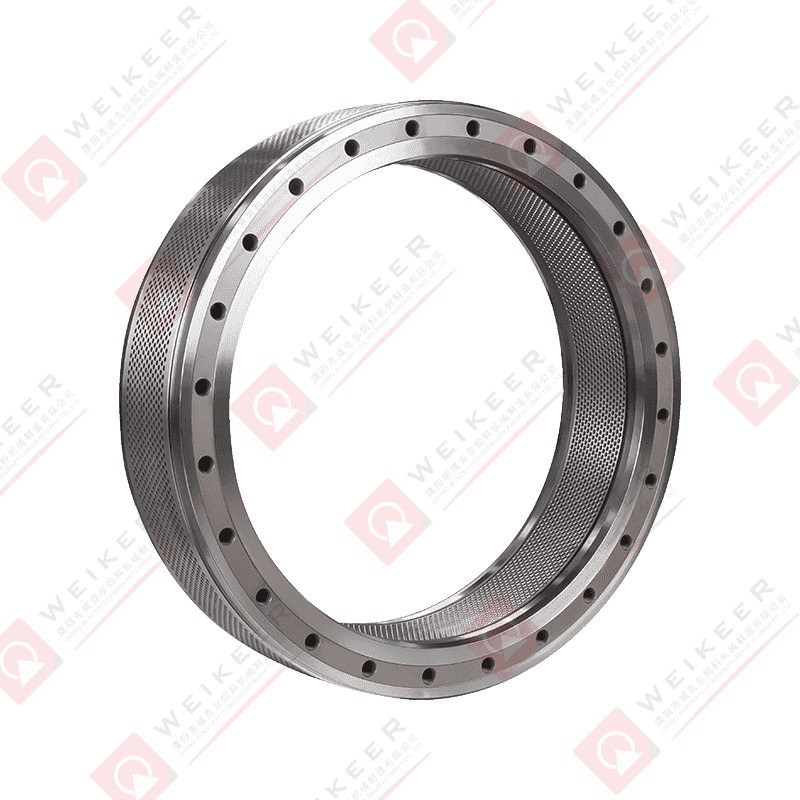In the global quest for renewable energy solutions, biomass pellets have emerged as a promising alternative to fossil fuels. Central to the production of these pellets are biomass pellet dies—precision-engineered components that shape raw biomass materials into compact, energy-dense forms.
One of the most significant advantages of biomass pellet dies lies in their ability to ensure consistent quality and uniformity in pellet production. These dies are designed with precise dimensions and hardened surfaces to withstand the immense pressure required to compress raw materials like wood chips, agricultural residues, or sawdust into dense pellets. This precision is critical for producing pellets that burn efficiently and meet industry standards for size, density, and durability.
For example, in industrial-scale biomass energy plants, pellet quality directly impacts combustion efficiency and emissions. Poorly formed pellets can lead to uneven burning, increased ash production, and higher maintenance costs for boilers and stoves. Biomass pellet dies address these issues by creating pellets with smooth surfaces and optimal hardness, ensuring they retain their shape during handling and storage while delivering consistent performance when burned.

The durability of pellet dies themselves is another standout feature. Made from high-carbon or stainless steel, these dies are engineered to resist wear and corrosion, even when processing abrasive materials like rice husks or corn stalks. Their longevity reduces downtime and replacement costs, making them an essential component for large-scale pellet production facilities. Additionally, advancements in die coatings—such as tungsten carbide or chrome plating—have further extended their service life, enhancing overall productivity.
Moreover, the versatility of biomass pellet dies allows them to accommodate a wide range of feedstock types. Whether producing pellets for residential heating, industrial power generation, or animal bedding, manufacturers can adjust die specifications (e.g., hole diameter, compression ratio) to tailor pellets for specific applications. This adaptability ensures that biomass pellet technology remains relevant across diverse sectors, supporting the transition to cleaner energy sources.
Supporting Sustainable Practices and Economic Growth
Another standout feature of biomass pellet dies is their role in promoting sustainable practices and driving economic growth. By enabling the efficient conversion of agricultural and forestry waste into valuable energy products, these dies contribute to circular economies and reduce reliance on non-renewable resources.
For instance, in rural communities, biomass pellet production powered by pellet dies provides a lucrative opportunity to monetize agricultural residues that would otherwise be discarded or burned in open fields. This not only generates income for farmers but also reduces air pollution and greenhouse gas emissions associated with traditional waste disposal methods. In developing countries, small-scale pellet mills equipped with durable pellet dies empower local entrepreneurs to produce affordable and eco-friendly fuel for cooking and heating.
The environmental benefits of biomass pellet dies extend beyond waste management. By replacing coal and other fossil fuels with biomass pellets, industries can significantly lower their carbon footprint. For example, co-firing biomass pellets in coal-fired power plants reduces net CO2 emissions without requiring extensive infrastructure modifications. Similarly, residential pellet stoves offer homeowners a cleaner and more sustainable alternative to traditional wood-burning fireplaces, improving indoor air quality and reducing deforestation.
Economic growth is another area where biomass pellet dies shine. The global demand for renewable energy has spurred investments in pellet production facilities, creating jobs in manufacturing, logistics, and research. From die manufacturers to pellet producers, the supply chain surrounding biomass pellet technology supports thousands of livelihoods worldwide. Furthermore, innovations in die design—such as modular configurations and self-cleaning features—are making pellet production more accessible and cost-effective for businesses of all sizes.
Addressing Challenges and Future Innovations
Despite their many advantages, biomass pellet dies face certain challenges. For example, the initial investment in high-quality dies can be prohibitive for small-scale operations. However, ongoing research is addressing this issue by developing affordable yet durable materials and designs tailored to specific applications.
Looking ahead, advancements in smart manufacturing and predictive maintenance promise to revolutionize biomass pellet dies. Sensors embedded in dies could monitor wear rates and operational parameters in real-time, allowing operators to optimize performance and schedule timely replacements. Such innovations will undoubtedly solidify pellet dies’ position as leaders in sustainable energy production.


 русский
русский Español
Español عربى
عربى 中文简体
中文简体











